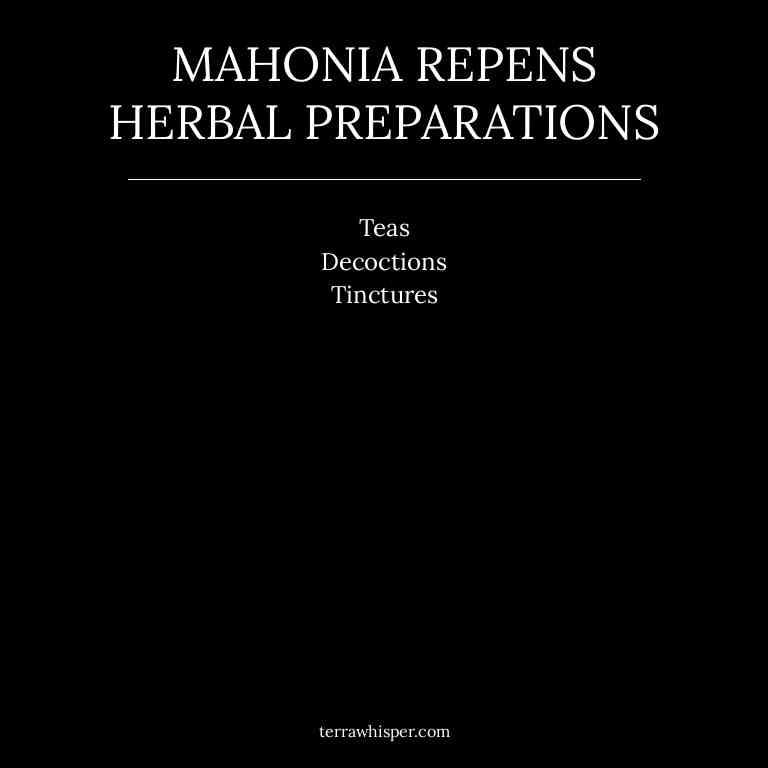Mahonia Repens Uses, Benefits, And Remedies

Mahonia repens, commonly known as creeping mahonia, is a low-growing evergreen shrub native to the Pacific Northwest of North America, valued for its ornamental foliage and medicinal properties.
This herb is used traditionally for its anti-inflammatory, antimicrobial, and digestive benefits, supporting overall wellness and aiding in the treatment of digestive disorders.
The bioactive constituents in Mahonia repens include berberine, alkaloids, and flavonoids, which contribute to its therapeutic actions.
Herbal preparations such as infusions, tinctures, and topical salves can be made from its leaves to harness its medicinal properties.
This page analize the most important medicinal aspects of Mahonia repens.
- Health Benefits
- Bioactive Constituents
- Medicinal Parts
- Herbal Preparations
- Side Effects of mahonia repens
Health Benefits
Mahonia repens fights fungal infections due to its high concentration of berberine, which inhibits the growth of fungi by disrupting their cell membranes and interfering with their metabolic processes.
It kills parasites and worms because the compound berberine also paralyzes the neuromuscular junctions of these organisms, leading to their death. Mahonia repens eases joint inflammation by reducing the production of pro-inflammatory cytokines and inhibiting enzymes that contribute to joint degradation. It treats skin cancer due to its ability to induce apoptosis in cancer cells and inhibit their proliferation through the activation of detoxifying enzymes.
Mahonia repens kills bacterial growth because berberine disrupts bacterial cell walls and inhibits essential enzymes required for bacterial survival.
The 10 best health benefits of Mahonia repens are shown in the image below.

The list below give a brief description of the 10 best health benefits of Mahonia repens.
- Fights Fungal Infections: Mahonia repens contains compounds that have antifungal properties, helping to combat fungal infections by inhibiting the growth of fungi.
- Kills Parasites Worms: The herb possesses anthelmintic properties that can help eliminate parasitic worms from the body, supporting digestive health.
- Eases Joint Inflammation: Mahonia repens may reduce inflammation in joints due to its anti-inflammatory compounds, providing relief from conditions like arthritis.
- Treats Skin Cancer: Some studies suggest that Mahonia repens may have properties that help in the treatment of skin cancer by inhibiting the growth of cancerous cells.
- Kills Bacterial Growth: The herb contains antimicrobial compounds that can inhibit the growth of bacteria, helping to prevent and treat bacterial infections.
- Treats Migraine Headaches: Mahonia repens may help alleviate migraine symptoms by reducing inflammation and relaxing blood vessels in the brain.
- Fights Cancer Cells: Research indicates that Mahonia repens may contain compounds that inhibit the growth of cancer cells, potentially supporting cancer treatment efforts.
Bioactive Constituents
Mahonia repens mahonia alkaloids have been extensively studied for their potential medicinal properties, including antitumor, antibacterial, and anti-inflammatory effects.
These alkaloids, such as berberine and cycloberberine, are known to inhibit the growth of cancer cells and reduce inflammation in the body. In addition to alkaloids, Mahonia repens contains isorhapontigenin, a flavonoid that exhibits strong antioxidant and anti-inflammatory activities, helping to protect cells from oxidative stress. Luteolin, another bioactive compound found in this herb, is a flavonoid with potent antioxidant and neuroprotective properties, which may support brain health and reduce the risk of neurodegenerative diseases.
The presence of various flavonoids in Mahonia repens contributes to its overall therapeutic potential, making it a valuable herb in traditional and modern medicine for treating a range of health conditions.
The 11 best bioactive constituents of Mahonia repens are shown in the image below.

The list below give a brief description of the 10 best bioactive constituents of Mahonia repens.
- Mahonia Alkaloids: A group of alkaloids found in Mahonia repens, known for their potential anti-inflammatory and antimicrobial properties.
- Isorhapontigenin: A flavonoid compound with antioxidant and anti-inflammatory effects, contributing to the herb's therapeutic properties.
- Luteolin: A flavonoid with strong antioxidant properties, known to reduce inflammation and support immune function.
- Flavonoids: A class of plant compounds with antioxidant, anti-inflammatory, and immune-modulating effects.
- Phenolic Acids: Natural compounds with antioxidant properties that help protect cells from oxidative stress.
- Quercetin: A flavonoid with potent antioxidant and anti-inflammatory properties, known for its health benefits.
- Kaempferol: A flavonoid with antioxidant and anti-inflammatory effects, also showing potential anti-cancer properties.
- Saponins: Plant compounds that may have cholesterol-lowering effects and can enhance immune function.
- Lignans: Natural compounds with antioxidant properties and potential benefits for cardiovascular and digestive health.
- Triterpenoids: A class of compounds with diverse biological activities, including anti-inflammatory and immune-modulating effects.
- Coumarins: Natural compounds with antioxidant and anticoagulant properties, often used for their therapeutic benefits.
Medicinal Parts
Mahonia repens leaf has been traditionally used in herbal medicine for its potential therapeutic properties, including anti-inflammatory and antimicrobial effects.
The leaves contain a variety of bioactive compounds such as alkaloids, flavonoids, and tannins, which contribute to their medicinal value. In traditional practices, the leaves are often prepared as a decoction or infusion to treat ailments like skin infections, digestive issues, and respiratory conditions.
The leaf's ability to support immune function and reduce inflammation makes it a valuable component in natural remedies. Additionally, the leaves may aid in detoxification processes within the body, supporting overall health and well-being.
While more research is needed to fully understand its pharmacological mechanisms, the historical use of Mahonia repens leaf highlights its significance in both traditional and complementary medicine systems.
Herbal Preparations
Mahonia repens teas are traditionally prepared by steeping the dried leaves and stems of the plant in hot water, often used to support digestive health and reduce inflammation.
These teas are valued for their mild, slightly bitter flavor and are commonly consumed as a natural remedy for gastrointestinal discomfort. The preparation process typically involves using one to two tablespoons of dried herb per cup of water, allowing it to steep for 10 to 15 minutes.
Decoctions, which involve boiling the plant material for a longer period, are another method used to extract more potent compounds, making them suitable for addressing conditions like skin irritations or respiratory issues. Tinctures, made by soaking the herb in alcohol or glycerin, offer a concentrated form of the plant’s active ingredients, often used for their antiseptic and analgesic properties.
Each preparation method highlights the versatility of Mahonia repens in traditional herbal medicine, offering different benefits depending on the desired therapeutic effect.
The 10 best herbal preparations of Mahonia repens are shown in the image below.

The list below give a brief description of the 10 best herbal preparations of Mahonia repens.
- Teas: Mahonia repens tea is traditionally used to support digestive health and alleviate mild gastrointestinal discomfort due to its mild astringent and anti-inflammatory properties.
- Decoctions: Mahonia repens decoctions are valued for their potential to support urinary tract health and may help in reducing inflammation and promoting diuresis.
- Tinctures: Mahonia repens tinctures are often used for their purported ability to support skin health and may aid in reducing inflammation and soothing irritations when applied topically.
Side Effects of mahonia repens
Mahonia repens heart beats fast due to its stimulating effects on the cardiovascular system, which can lead to palpitations or tachycardia in sensitive individuals.
This herb may also cause lungs to feel tight, potentially triggering respiratory distress in those with pre-existing lung conditions. Brain fog and fatigue are common side effects, likely due to the herb's impact on neurotransmitter balance and cognitive function.
The liver may feel swollen as a result of increased metabolic activity or toxicity, while stomach pain and a feeling of fullness suggest gastrointestinal irritation or delayed digestion. Additionally, Mahonia repens can lead to dry mouth, hair loss, and kidney weakness, indicating systemic effects that require careful monitoring.
Skin numbness and tiredness further highlight its potential to disrupt multiple bodily functions, emphasizing the need for caution and professional guidance when using this herb.
The 11 most common side effects of Mahonia repens are shown in the image below.

The list below give a brief description of the 11 most common side effects of Mahonia repens.
- Heart Beats Fast: Mahonia repens may stimulate the cardiovascular system, leading to an increased heart rate.
- Lungs Feel Tight: The herb might cause respiratory constriction or irritation, making breathing feel restricted.
- Brain Feels Foggy: It may affect cognitive functions, leading to a feeling of mental confusion or cloudiness.
- Liver Feels Swollen: Mahonia repens could potentially cause liver inflammation or congestion, leading to a swollen liver.
- Stomach Feels Pain: The herb may irritate the stomach lining, causing discomfort or pain.
- Stomach Feels Full: It might slow digestion or cause a sensation of fullness even after eating small amounts.
- Mouth Feels Dry: Mahonia repens may have a drying effect on the mouth, leading to dryness and reduced saliva production.
- Hair Falls Out: It may interfere with hair growth cycles, leading to increased hair loss.
- Kidneys Feel Weak: The herb could potentially impact kidney function, leading to a feeling of weakness or reduced efficiency.
- Skin Feels Numb: It may affect nerve function, causing a tingling or numbness sensation in the skin.
- Brain Feels Tired: Mahonia repens might have a sedative effect, leading to a feeling of mental fatigue or exhaustion.